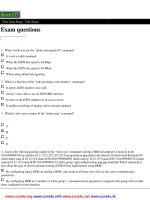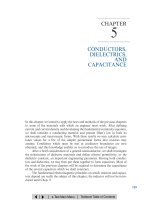Chapter5 b
Bạn đang xem bản rút gọn của tài liệu. Xem và tải ngay bản đầy đủ của tài liệu tại đây (397.77 KB, 36 trang )
Summary of MAC protocols
What do you do with a shared media?
Channel Partitioning, by time, frequency or code
• Time Division,Code Division, Frequency Division
Random partitioning (dynamic),
• ALOHA, S-ALOHA, CSMA, CSMA/CD
• carrier sensing: easy in some technoligies (wire), hard in others (wireless)
• CSMA/CD used in Ethernet
Taking Turns
• polling from a central cite, token passing
5: DataLink Layer
5a-1
LAN technologies
Data link layer so far:
services, error detection/correction, multiple access
Next: LAN technologies
addressing
Ethernet
hubs, bridges, switches
802.11
PPP
ATM
5: DataLink Layer
5a-2
LAN Addresses and ARP
32-bit IP address:
network-layer address
used to get datagram to destination network (recall IP network
definition)
LAN (or MAC or physical) address:
used to get datagram from one interface to another physically-
connected interface (same network)
48 bit MAC address (for most LANs)
burned in the adapter ROM
5: DataLink Layer
5a-3
LAN Addresses and ARP
Each adapter on LAN has unique LAN address
5: DataLink Layer
5a-4
LAN Address (more)
MAC address allocation administered by IEEE
manufacturer buys portion of MAC address space (to assure
uniqueness)
Analogy:
(a) MAC address: like Social Security Number
(b) IP address: like postal address
MAC flat address => portability
can move LAN card from one LAN to another
IP hierarchical address NOT portable
depends on network to which one attaches
5: DataLink Layer
5a-5
Recall earlier routing discussion
Starting at A, given IP datagram
addressed to B:
A
223.1.2.1
look up net. address of B, find B on same
net. as A
link layer send datagram to B inside linklayer frame
frame source,
dest address
B’s MAC
addr
B
datagram source,
dest address
A’s IP
addr
A’s MAC
addr
223.1.1.1
B’s IP
addr
223.1.1.2
223.1.1.4 223.1.2.9
223.1.1.3
223.1.3.27
223.1.3.1
223.1.2.2
E
223.1.3.2
IP payload
datagram
frame
5: DataLink Layer
5a-6
ARP: Address Resolution Protocol
Question: how to determine
MAC address of B
given B’s IP address?
Each IP node (Host, Router) on
LAN has ARP module, table
ARP Table: IP/MAC address
mappings for some LAN nodes
< IP address; MAC address; TTL>
< ………………………….. >
TTL (Time To Live): time after
which address mapping will be
forgotten (typically 20 min)
5: DataLink Layer
5a-7
ARP protocol
A knows B's IP address, wants to learn physical address of B
A broadcasts ARP query pkt, containing B's IP address
all machines on LAN receive ARP query
B receives ARP packet, replies to A with its (B's) physical layer
address
A caches (saves) IP-to-physical address pairs until information
becomes old (times out)
soft state: information that times out (goes away) unless
refreshed
5: DataLink Layer
5a-8
Routing to another LAN
walkthrough: routing from A to B via R
A
R
B
In routing table at source Host, find router 111.111.111.110
In ARP table at source, find MAC address E6-E9-00-17-BB-4B, etc
5: DataLink Layer
5a-9
A creates IP packet with source A, destination B
A uses ARP to get R’s physical layer address for 111.111.111.110
A creates Ethernet frame with R's physical address as dest, Ethernet frame
contains A-to-B IP datagram
A’s data link layer sends Ethernet frame
R’s data link layer receives Ethernet frame
R removes IP datagram from Ethernet frame, sees its destined to B
R uses ARP to get B’s physical layer address
R creates frame containing A-to-B IP datagram sends to B
A
R
B
5: DataLink Layer 5a-10
Ethernet
“dominant” LAN technology:
cheap $5 for 100Mbs!
first wildey used LAN technology
Simpler, cheaper than token LANs and ATM
Kept up with speed race: 10, 100, 1000 Mbps
Metcalfe’s Etheret
sketch
5: DataLink Layer 5a-11
Ethernet Frame Structure
Sending adapter encapsulates IP datagram (or other network layer
protocol packet) in Ethernet frame
Preamble:
7 bytes with pattern 10101010 followed by one byte with pattern
10101011
used to synchronize receiver, sender clock rates
5: DataLink Layer 5a-12
Ethernet Frame Structure (more)
Addresses: 6 bytes, frame is received by all adapters on a LAN and
dropped if address does not match
Type: indicates the higher layer protocol, mostly IP but others may
be supported such as Novell IPX and AppleTalk)
CRC: checked at receiver, if error is detected, the frame is simply
dropped
5: DataLink Layer 5a-13
Ethernet: uses CSMA/CD
A: sense channel, if idle
then {
transmit and monitor the channel;
If detect another transmission
then {
abort and send jam signal;
update # collisions;
delay as required by exponential backoff algorithm;
goto A
}
else {done with the frame; set collisions to zero}
}
else {wait until ongoing transmission is over and goto A}
5: DataLink Layer 5a-14
Ethernet’s CSMA/CD (more)
Jam Signal: make sure all other transmitters are aware of collision; 48
bits;
Exponential Backoff:
Goal: adapt retransmission attemtps to estimated current load
heavy load: random wait will be longer
first collision: choose K from {0,1}; delay is K x 512 bit
transmission times
after second collision: choose K from {0,1,2,3}…
after ten or more collisions, choose K from {0,1,2,3,4,…,1023}
5: DataLink Layer 5a-15
Ethernet Technologies: 10Base2
10: 10Mbps; 2: under 200 meters max cable length
thin coaxial cable in a bus topology
repeaters used to connect up to multiple segments
repeater repeats bits it hears on one interface to its other interfaces: physical layer device only!
5: DataLink Layer 5a-16
10BaseT and 100BaseT
10/100 Mbps rate; latter called “fast ethernet”
T stands for Twisted Pair
Hub to which nodes are connected by twisted pair, thus “star
topology”
CSMA/CD implemented at hub
5: DataLink Layer 5a-17
10BaseT and 100BaseT (more)
Max distance from node to Hub is 100 meters
Hub can disconnect “jabbering adapter
Hub can gather monitoring information, statistics for display to
LAN administrators
5: DataLink Layer 5a-18
Gbit Ethernet
use standard Ethernet frame format
allows for point-to-point links and shared broadcast channels
in shared mode, CSMA/CD is used; short distances between nodes
to be efficient
uses hubs, called here “Buffered Distributors”
Full-Duplex at 1 Gbps for point-to-point links
5: DataLink Layer 5a-19
Interconnecting LANs
Q: Why not just one big LAN?
Limited amount of supportable traffic: on single LAN, all stations
must share bandwidth
limited length: 802.3 specifies maximum cable length
large “collision domain” (can collide with many stations)
limited number of stations: 802.5 have token passing delays at each
station
5: DataLink Layer 5a-20









